Words by Rodney Hayward, woodwork by Peter Giles, photos by Stuart Hay.
The Chinese Ming dynasty (1368–1644) furniture makers effortlessly set their souls into their material. Their work is more than just furniture; it is an idea, even an ideal; a spiritual goal. The hardwood furniture that we associate with these makers was created from the mid-period of that dynasty onwards and was centred on the city of Suzhow on the lower Yangtze River. This furniture is still readable as ‘modern’ by Western eyes and contains relationships between form and structure that challenge our contemporary design language. There is stillness in this furniture and an intense purity: its power is in its intellectual and structural elegance.
The Ming Ceremonial Tea Table described here (see Gustave Ecke, Chinese Domestic Furniture, Beijing, Henri Vetch, 1944), was made in bubinga (Guibourtia demeusei) by Peter Giles as part of a body of work he created for the degree of Master of Visual Arts. The quest was not about reproduction of a form, but rather it was about what could be sensed about unrecorded, past artisan practices through handwork today. Furniture documents its time of making. It documents technology and social ritual: furniture catches time in its structure like a fly in amber.
The making of this table was an investigation into craftsmanship and skill. There is in any craft an unconscious, tacit intelligence gained through repetitious action of the hands and body. Practice does not necessarily make perfect, but it does create habit—the focus of performative action is through the whole body. A higher, more slowly acquired, level of skill comes from the conscious, anticipating, coupled gesture of the eye, the fingers, the tool, the resistance of the material and the intent. Sensitivity grows from skill born of the moment from the re-iterative sensing of how tight is tight, and how sharp is sharp?
Ming joinery
While style is set within social context and influences, it also derives from knowledge. Stylistic change may well be associated with technological and/or material change as much as prompting by social change. The stunning complexity of Ming joinery evolved within cultural and societal changes in China over something like a millennium.
The principles were mastered in the Han Dynasty (206BC–9AD), contemporary furniture typologies began being formulated in the Tang dynasty (618–907AD) and by the 11th century, today’s furniture forms were largely in place. During Emperor Longqing’s administration (1537-1573), the freeing of stricture on overseas trade saw the importation of superb tropical hardwoods from south Asia. The structural and working qualities of these timbers were to define the outcome of form and surface of Ming hardwood furniture.
Furniture derives to a degree, its design vitality, articulation—and stability—from the treatment of the vertical meeting the horizontal as in a table, chair or stool. In classic Chinese furniture, there may be a constructed sub-top to give a ‘waist’ (akin to a skirt or apron in Western furniture) or alternatively, the furniture is ‘waistless’ when the legs are tenoned directly into the top. The outcome is two stylistic genres: the former gives an open, usually stretcher-free, defined spatial volume. In the waistless construction, stretchers almost always complicate the under-structure.
The little Ming ceremonial tea table contains no fewer than ten jointing systems for bringing two or more of its separate elements together. Included is the classic synergistic coupling of the embracing shoulder joint and the giant’s arm brace with its hook-and-plug tenon. Each joint type brought its singular set of layout and making problems, but the fitting of each individual joint to work in concert was extraordinarily demanding. If the structure was orthogonal (at right angles) it would have been difficult enough, but as in much Ming furniture, the legs of the table are slightly splayed so the joinery had to be reasoned, cut and fitted to give a compound angle of 1.5°.
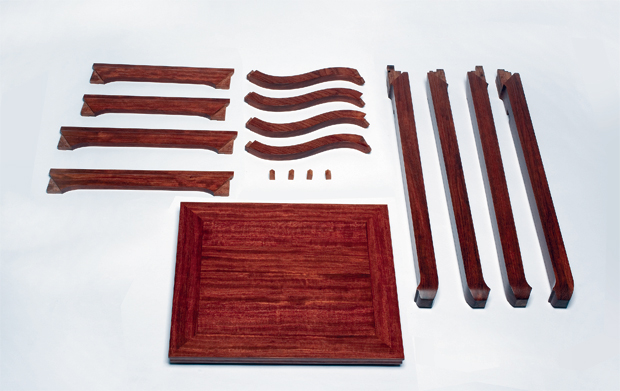
Above: The pre-assembled top contains eight components and is shown with the twelve disassembled components of the under-structure.
Embracing shoulder joint
The embracing shoulder joint is ideal for the waisted construction of this table. It is a joint that melds together the horizontal and vertical through a barely interrupted flow of fibre. A multiplicity of shoulders is generated within the joint. When well fitted, these provide large load-bearing surfaces locked into place by each joint’s sliding, wedging dovetail key. In cutting the joint, there is a large amount of endgrain material to be removed as deep as 80mm from within the leg. And, the sliver of stock that’s left to form the locking dovetail’s tenon complicates the removal of the waste. From our drill-and-pare solution, it’s likely that traditionally a bow drill would have been used to remove much of the superfluous material.
It is a joint where it is wise to leave margins: to build in whiskers of material for final fitting so as not to imperil the show-surface profiles. One measure would be to bring the tenon of the dovetail a little further inboard than shown in Ecke’s drawings. Do it and learn.
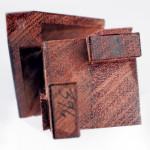
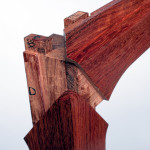
Above left: Plan view of the top of the leg showing the stub tenons and the in situ-formed sliding dovetails. The deep recesses accommodate the tenons of the waisted apron. Above right: Partial assembly of skirt to leg. The sliding dovetail has engaged at this point as has the tenon of the waisted apron.
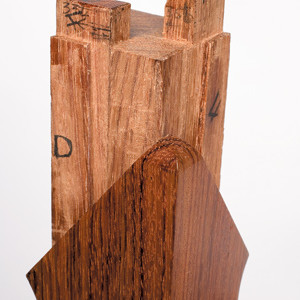
Above: Top leg join. This is the foundation joinery of the embracing shoulder joint—mitres, dovetail and stub tenons.
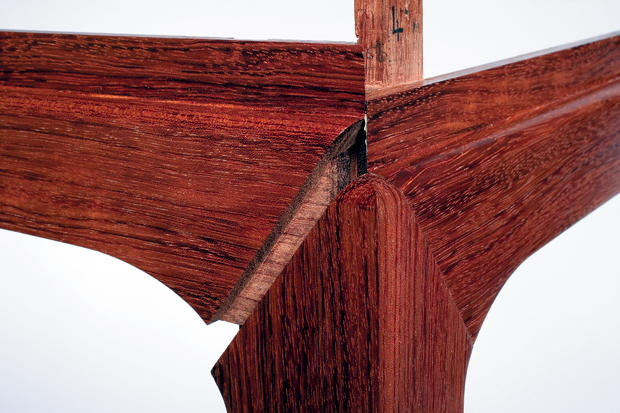
Assembly of the corner near completion. Although difficult to assess in the photo, the mitre joint is compounded by 2°.
Giant’s arm brace
The giant’s arm brace seems to have had a long and, for furniture, colourful history. It is one of those smart, clever things you wish you had thought of yourself. It is a neat solution to bracing the leg to superstructure. In its making, it projects out there in space with seemingly no datum points. It is truly a flying buttress thing. The fitting of the joint is as dynamic as flight: the arm moves vertically as the fitting of the hooked tenon into the leg is sought and then in the horizontal plane to address the splay of the leg.
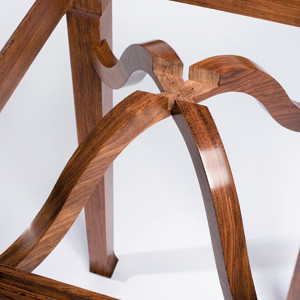
The under-structure assembly partially complete, with the four giant’s arm braces in place. The ‘in space’ complexity of this joint is fully evident.
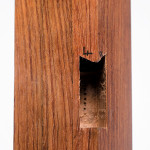
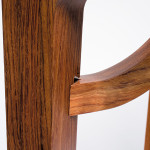
Above left: The ‘open’ deep mortise for giant’s arm brace. Above right: When fitting this ‘hook-and-plug’ joint, the brace will next be pushed vertically by the insertion of a wedge or key into the lower end of the mortise.
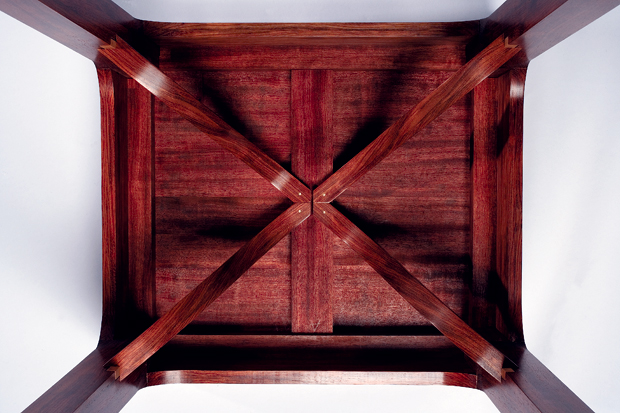
The lapped tips of the braces are located with bamboo pins. The gap is required to disassemble the structure and traditionally would have been hidden under an embracing cap.
Two questions emerged from this study that were not obvious at the onset: what was the quality of the steel in the edge tools used by these Ming craftsmen?—and how did they sharpen them? The key to Ming hardwood furniture is the facility to do complex joinery in iron-hard timbers and, in turn, the key to that is steel and abrasives. Both are used up in the practice of the craft, and yet both are central to that practice.
Rodney Hayward was Head of the Furniture/Wood Design Workshop, ANU School of Art, Australian National University from 1990 to 2010.












